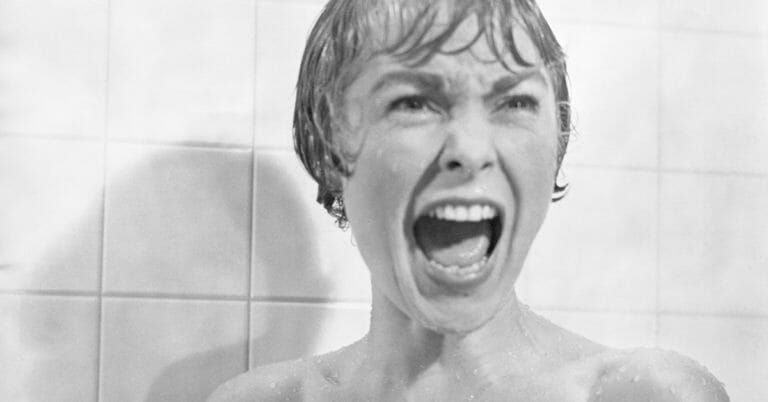Sign up for the
TSL Newsletter
and get $50 off Final Draft 12
By Clare Nina Norelli · March 28, 2018

One of cinema’s greatest director/composer relationships was that of Alfred Hitchcock and Bernard Herrmann. The pair first began working together in 1955 on the darkly comedic The Trouble with Harry, collaborating on a further seven films before having a falling out over the score for Torn Curtain (their ninth film together) in 1966. Their partnership yielded wonderful results because Herrmann had an implicit understanding of what Hitchcock was trying to achieve in his films. He appreciated that Hitchcock was not just going for cheap thrills or titillation in his films but ongoing psychological tension. Through his smart compositional choices, Herrmann was able to mirror sonically Hitchcock’s themes of dread, fear, anxiety, and longing.
Herrmann’s score for Hitchcock’s Psycho (1960) is arguably the greatest horror film score ever composed. It set a standard for the role of music in the horror film and proved that the score need not merely fade into the background and function as barely noticeable auditory wallpaper. His compositions went beyond just mimicking the onscreen action to elicit scares—they provided an undercurrent of unease that proved vital to the success of the whole film. Even Hitchcock recognized the power of Herrmann’s score, later admitting that “33% of the effect of Psycho was due to the music.”
Here are four reasons why Psycho’s score scares:
Musical dissonance is created through using tones that do not complement each other at the same time. This creates a jarring sound that results in a listener unconsciously desiring harmonic resolution to a more pleasant, or consonant sound. Herrmann’s iconic stabby “Murder” cue for the film’s infamous shower scene is a perfect example of the sonic capabilities of dissonance. The cue has remained one of the most famous pieces of film music ever written and has been referenced in numerous other television shows and films.
Due to budget constraints, Herrmann had to work with a reduced ensemble. Though usually a composer who masterfully employed a rich array of orchestral color, Herrmann instead decided that because the film itself was in black and white that he should use a “black and white score.” His musical interpretation of this was to use an orchestra solely comprised of strings. Uniform orchestration could have meant a uniform sound world, but Herrmann exploited the possibilities of the strings by employing a wide range of instrumental techniques to garner unusual and unnerving results.
In repeating motifs and rhythms, Herrmann creates a restlessness in much the same way does through using dissonance. The score feels unending and its resistance to resolution is transferred unconsciously to the audience, who watch the onscreen action with baited breath. Herrmann’s “Main Theme” (sometimes referred to as “Prelude”) sets up an atmosphere of dread from the moment the opening credits begin through its use of repetition. With Saul Bass’ titles as the only visual, Herrmann’s relentless strings set the tone, informing the audience that what is to come is not going to be an easy watch.
Psycho’s narrative involves a love story between the ill-fated Marion Crane and her boyfriend Sam. There are moments in the score that are more subdued and ruminative, and this reflects not only the couple’s romance, but Marion’s humanity. These cues contrast with the dissonant, aggressive cues in the score, allowing them greater prominence when they need to exact their power on the audience.
 Clare Nina Norelli is a composer, musician, teacher and writer. She currently writes Scores on Screen, a column on film music for MUBI’s Notebook and in February of 2017 her first book Soundtrack from Twin Peaks was published as part of Bloomsbury’s 33 1/3 series. You can follow her on twitter @clarenorelli.
Clare Nina Norelli is a composer, musician, teacher and writer. She currently writes Scores on Screen, a column on film music for MUBI’s Notebook and in February of 2017 her first book Soundtrack from Twin Peaks was published as part of Bloomsbury’s 33 1/3 series. You can follow her on twitter @clarenorelli.
Photo Credit: Paramount
For all the latest from The Script Lab, be sure to follow us on Twitter, Facebook, and Instagram.